This science ClipArt gallery offers 102 images of methods to produce power by steam, including the coal-powered steam engine often seen on early trains and steamboats.
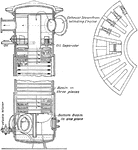
Interior View of Rateau Accumulator
"The accumulator may consist of a large tank in which are numerous plates over which water can flow,…
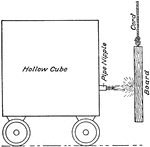
Apparatus for Measuring Jet Stream of Steam
"Suppose a hollow cube to be filled with some fluid (water or steam) at a given pressure, and to have…

Yorkshire Steam Wagon Transverse Boiler
A Yorkshire steam wagon transverse boiler. Water is continuously enters the large cylindrical container.…
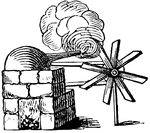
Brancas Engine
"In 1629 Giovanni Branca, an Italian, contrived a machine which was employed for the various purposes…
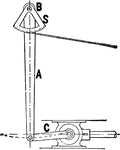
Reducing Motion of Piston and Indicator using Brumbo Pulley
A pulley system used to reduce motion between the piston and the indicator of the steam engine. The…

Steam Engine Valve Centered with Piston
"It is usual to put the engine on center before setting the valve. First put the engine in a position…

Centrifugal Mill
"The upright cyclinder a, is a tube which has a funnel shaped mouth for the admission of the stream…

Two Gas Jets Beneath Wire Gauze wiPower Generation, Steamth a Lit Flame
"If a piece of wire gauze is held over an unlighted gas jet, the gas may be lighted on either side (figure…
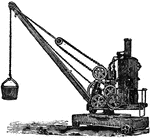
Steam Crane
"A Crane is a machine for lifting weights, worked either by hand or by steam, or by hydraulic power.…
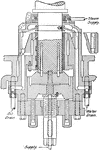
Cross Sectional View of Curtis Turbine Step Bearing
"The upper bearing with dowel—pins and key fit into corresponding dowel holes and key—way…

Mechanical Drawing of a Metal Cylinder
"Steam is admitted under pressure for a boiler into a metal cylinder behind a piston, as represented…

Thermodynamic Vaporization Diagram using Water in Cylinder with Piston
An illustration of thermodynamic vaporization of water in a cylinder with piston. The cylinder filled…
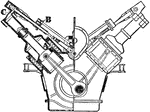
Bentley Eight Cylinder Diagonal Tandem Compound Superheated Steam Engine for Tractor
A eight cylinder Bentley superheated steam engine fitted to a tractor. The steam is used to move the…
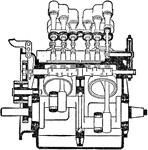
Sheppee Motor Company Compact Double Acting SUperheated Engine
"In this engine the cam—shaft by which the steam and exhaust valves are operated is situated midway…

Steam Engine with Reynolds Corliss Gear
"An eccentric on the main shaft gives an oscillating motion to a circular disc called the wrist plate,…

Savery's Engine
"Handle A opens and closes valves B and G. Steam is injected through pipe S which flushes any air/water…

Steam engine
"The steam engine is a powerful device for utilizing the energy involved in the elasticity and expansive…
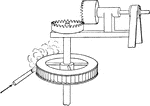
Steam Rotary Engine
An illustration of a rotary steam engine. The steam turbine system was invented by Branca in 1629. Steam…
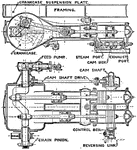
Twin Cylinder Steam Engine Fitted to Sentinel Wagons
Illustration showing a twin cylinder steam engine fitted to a sentinel wagon. The steam expands and…

Cross Sectional View of U.S.S Salem Steam Engine Showing Curtis Turbines
"The marine turbine of this type (Curtis turbine) installed in the U.S. Cruiser Salem had seven pressure…
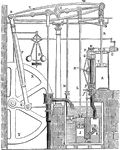
Watt's Double-Acting Condensing Steam-Engine
"Used a boiler to produce steam, chambers to condense it, and drive the pistons of the engine." —Quackenbos…
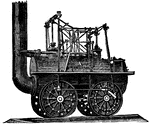
George Stephenson's First Locomotive
"George Stephenson is emphatically the engineer to whose intelligence and perseverance we owe the introduction…
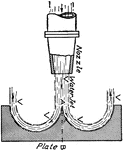
Force Measurement by Deflecting Water Jet 180 Degrees
"Now if the plate were shaped as shown, so that the direction of the jet were completely reversed turned…

Steam-engine Force Pump
"The force-pump differs from others in having its piston solid, or without a valve, and also in having…

Cross Sectional View of Four Stage Vertical Riedler Stumpf Turbine
A cross sectional view of a four stage vertical Riedler—Stumpf turbine. The steam enters and exit,…

Fowler's Steam-engine
"In 1854, Mr. Fowler exhibited his patent steam-draining apparatus at the Lincoln meeting of the Royal…
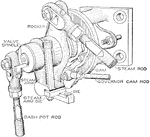
Steam Engine Brown Releasing Gear
"The governor cam rod operates a plate cam having a curved slot so shaped that it takes place of both…

Close up of Reynolds Corliss Gear from Steam Engine
"The steam arm is keyed to the valve spindle which passes loosely through a bracket on which the bell—crank…

Steam Engine with Walschaert Gear on Railroad
An illustration of the steam engine with Walschaert gear system on rail tracks. The piston moves the…
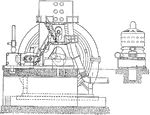
5000 kW Corliss and Curtis Steam Engine for Electric Generation
An illustration of a Corliss steam engine to generate 5000 kW of electricity. The turbines to create…
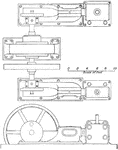
Corliss Steam Engine Generator Plan
"By placing the condensers underneath the turbine, as is frequently done at the present time, not only…

Cross Section View of Rateau Turbine Electric Generator by Western Electric Company
A cross sectional view of Rateau electric generator turbine by Western Electric Company. Steam is used…

De Laval Steam Turbine Connected to Generator
A De Laval steam turbine connected to a generator. The turbine generates electricity by turning the…

DeLaval Steam Electric Generator
"The bearings are of the plain ring—oiling type, usually provided with water jackets. The shaft…

Pearsons Turbine for Electricity Generator
A cross sectional view of the Pearsons turbine for generating electricity. The turbines, located in…

Westinghouse Turbo Steam Engine Generator Plan
"Turbines require very much smaller foundations than reciprocating engines reciprocating engines of…

Zoelly Condensing Turbine Electric Generator
"The Zoelly turbine has been developed rather extensively abroad, and is being manufactured largely…
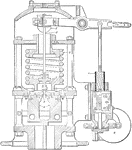
Sectional View of Governor for Varying Number of Nozzles Opened
"In the Curtis turbine, steam is admitted through a series of valves, the number of which depends upon…

Turbine Governor for Varying Time of Admission
"An admission of steam occurs about once in every thirty revolutions at approximately full load. The…
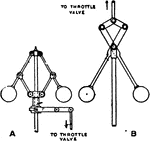
Watt's governor
"Watt's method of regulation, which consists in varying the pressure of the steam supplied to the engine…

Grasshopper-Beam
"Grasshopper-beam. a, rocking pillar; b, radius-bar of the parallel motion which secures verticality…
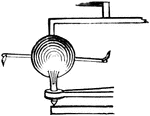
Hero's Machine
"Hero's Machine. The generation of steam from water by the application of heat, and the mechanical force…
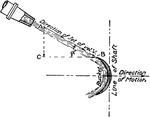
Jet Steam Stream Hitting Curved Vane
"If a jet with the velocity V strikes the bucket at an angle a, its velocity A B could be resolved into…
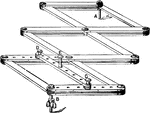
Horizontal Pivot Pantograph for Motion Reduction between Piston and Steam Engine Indicator
"It is placed horizontally with the pivot, B, resting on a support opposite the crosshead when in mid—position.…
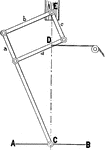
Motion Reduction using Pantograph of Piston Connected to Indicator of Steam Engine
A pantograph used to reduce motion of the piston. At point D, a string is attached to the indicator,…

Cross Sectional View of Parsons Turbine
"Steam enters at E and gradually expands in volume until it exhausts at G. The rotor is usually built…
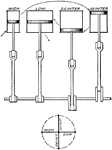
Quadruple Expansion Engine Piston
A piston system from a quadruple expansion engine showing the movement of steam. Steam first enters…
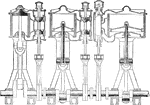
Piston of a Triple Expansion Steam Engine
A piston diagram from a triple expansion steam engine. The three cylinders are designed at high, medium,…
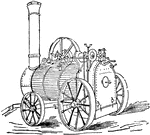
Portable Steam-Engine
A portable, external, combustion heat engine that converts steam in to mechanical work.

Water Pulsometer
"An instrument of the pump kind for raising water, especially when that liquid is mixed with solid matter.…
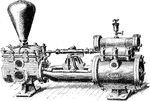
Direct Acting Steam Pump
"The direct—acting steam pump has the steam piston at one end of a rod and the water position…
!["Steam pumps are force pumps operated by steam acting on the piston of a steam engine directly connected to the pump, and in many cases cast with the pump. A section of a double-acting steam pump, showing the steam and water cylinders, with other details, is illustrated [here]." —Hallock 1905](https://etc.usf.edu/clipart/36100/36172/steam_pump_36172_mth.gif)
Steam Pump
"Steam pumps are force pumps operated by steam acting on the piston of a steam engine directly connected…

Application of Steam Engine Jet Condenser used to Pump Well Water
An illustration showing the application of a jet condenser to pump a well. The steam enters the engine…
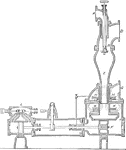
Steam Engine Jet Condenser with Pump
A sliced view of a jet condenser with pump. The steam enters at D, while cold water enters at A. The…

A Pair of Concave Mirrors Set Facing Each Other
"If a pair of concave mirrors be set facing each other, as shown in figure 7, and a source of heat be…
Steam Engine Valve with Lap Connected to Rocker
"This occurs in horizontal engines when the valve is set on top of the cylinder instead of on one side.…

Connecting Rod of a Steam Engine
This illustrates how to determine the force required to turn a connecting rod of a steam engine.
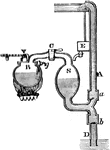
Savery Engine
"Savery's Steam Engine. The adjoining figure illustrates the apparatus employed by Savory. It consists…

Valve with Lap of Steam Engine at Extreme Left with Exhaust Ports Open
"Since the valve must move a distance equal to the outside lap before admission can take place, it is…

Steam Engine
"Newcomen's Atmospheric Steam-Engine. A, A, working-beam; B, boiler from which steam is admitted through…